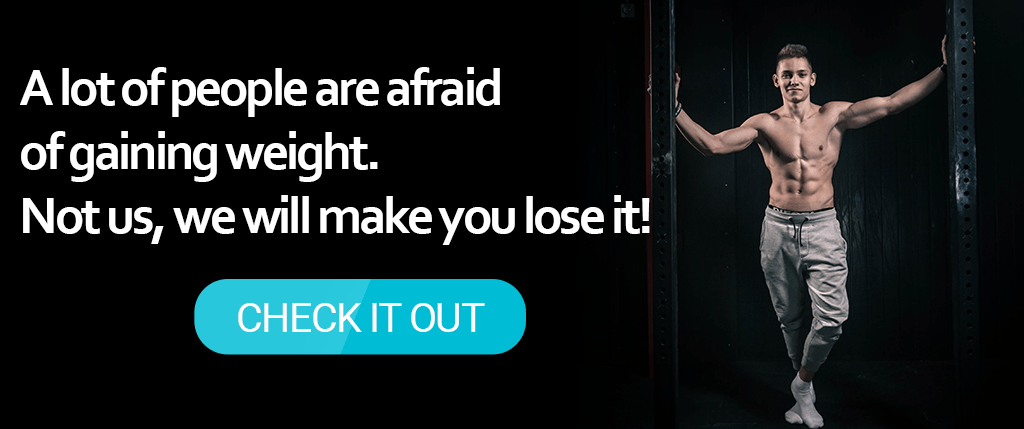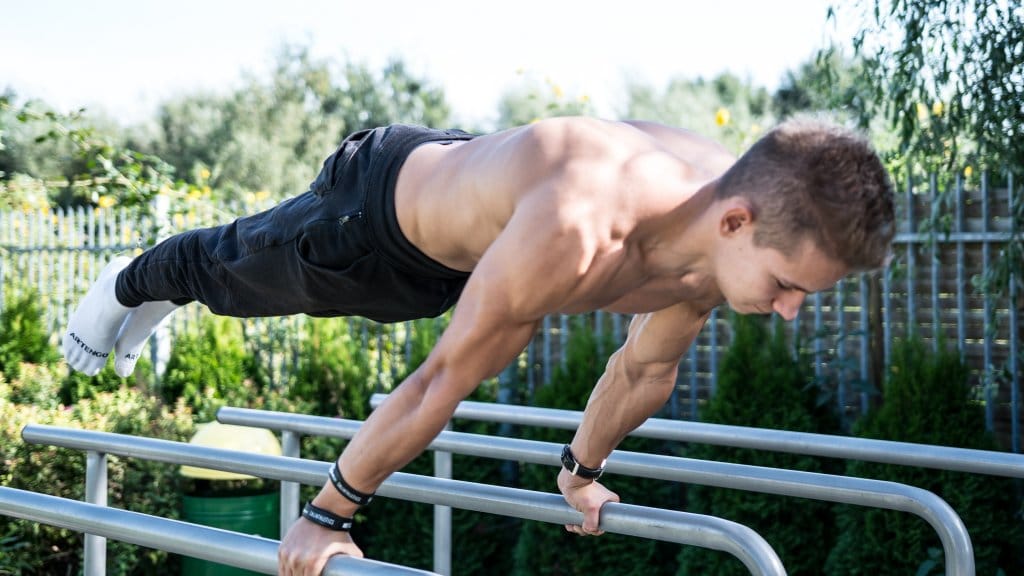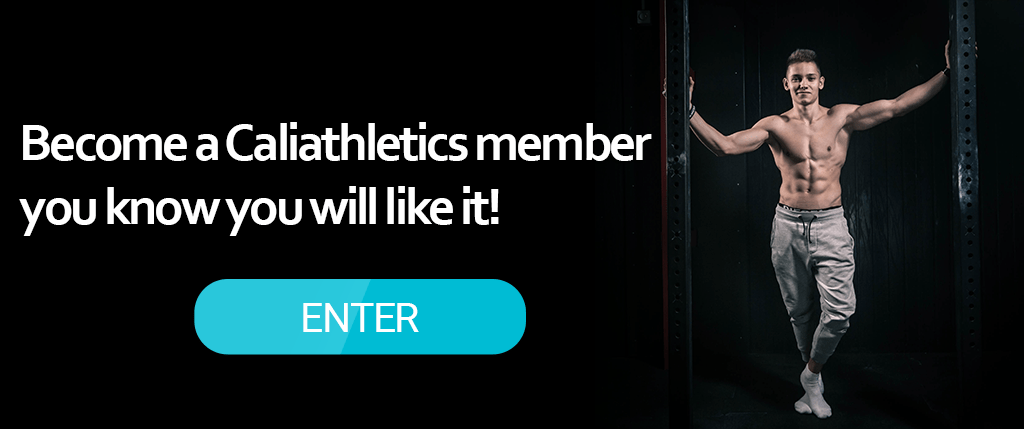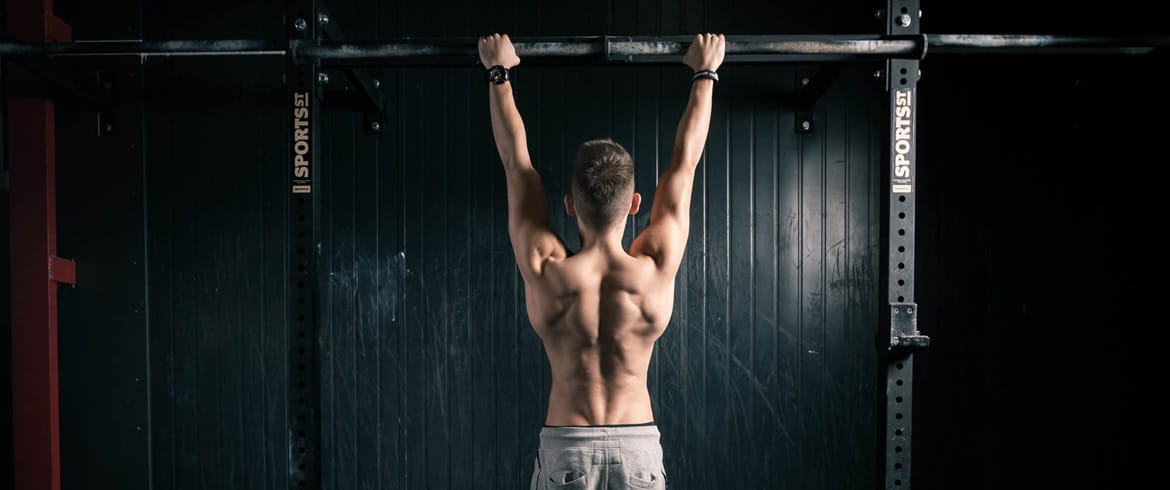
Introduction to Calisthenics
What is Calisthenics?
Calisthenics, also called Street Workout, gained worldwide reputation after 2008 video of Hannibal for King went viral on YouTube. Since then, increasingly more people have trained it as well as national and international competitions have emerged. It derives its name from two Greek words kálos which means beauty and sthénos which means strength. Calisthenics is a discipline in which you train your whole body using only bodyweight exercises. You have probably seen people doing gravity-defying gymnastic figures such as Front Lever and Planche or dynamic acrobatic skills on the bars such as Muscle Up. This is the sole idea of Calisthenics – to perform workouts with nothing else but your own body.
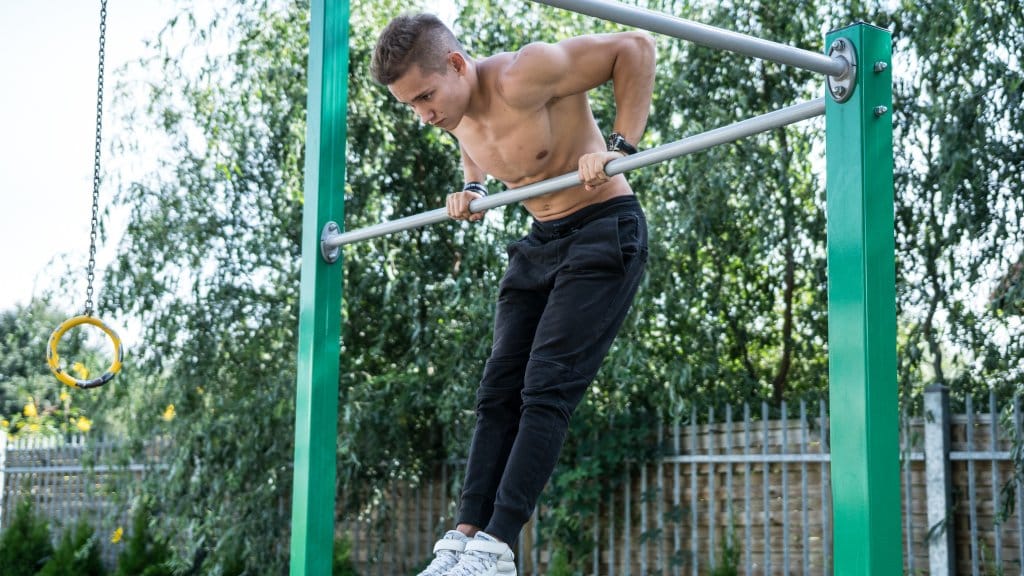
During usual Calisthenics workouts the exercises usually involve presses and pulls
They enhance your body’s strength, endurance, coordination, flexibility and also give you this ripped look that many want to achieve. Think of movements such as push ups, pull ups, dips, squats. Little do people know how many of different variations of exercises are there to train their body. Do not worry, this guide is here to help you get started and make sense of Calisthenics.
Calisthenics is also appealing for one very good reason. It combines functionality and true bodyweight strength with aesthetic shredded look. That being said, not only will you develop muscle power but also impressive physique along that.
So do you want to step up your game? Continue reading to find out how!
Why should you train Calisthenics?
I could write down dozens of benefits of Calisthenics workout, but I will stick to the most crucial ones. So is Calisthenics for you? Even though I do not know you, I can almost surely say – YES.
No equipment needed
If for whatever reasons you are not able to go to gym on a regular basis there is nothing wrong with that. Calisthenics exercises allow you to train wherever you like. You only need a bit of a floor space and a pull-up bar (you can get one from Amazon for a few dollars).
Different level of exercises in Calisthenics
There are hundreds of variations of bodyweight exercises. That being said, it does not matter if you are new to Calisthenics or have been actively training various sports for years. You will always find an exercise that challenges you. For example, a beginner might stick to knee-assisted push ups whereas an advanced athlete could go for one arm push ups. This holds true for any other movements so you will always find something for yourself.
Weight loss or muscle mass gain
With Calisthenics you can lose your weight as well as gain muscle mass. This only depends on how you structure your Calisthenics workout (I will cover it in the following sections). For bodyweight loss you will want to involve more compound exercises which burn more calories than usual weight-lifting. For muscle mass there are plenty of resistance exercises such as pull ups and dips, among others. You can always add additional weight if normal exercises are not enough for you!
Develop natural body strength
The beauty of Calisthenics is that you train using natural movements of your body. Having said that, you develop natural body strength. You also involve all minor parts of your muscles as well as strengthen your joints.
Advanced skills in Calisthenics
Do not get discouraged when you see all of these advanced movements. Out of thousands of people training Calisthenics only a part of most devoted athletes decide to go for the hardest skills like these written before. But if you are reading this we assume that you are one of them. And we will teach you and show you how to do Muscle Ups, Front Lever, Human Flag, Planche, and others.
As I mentioned before, there are many benefits of Calisthenics and you can perform Calisthenics workouts in different ways depending on what is your goal. Check out this article if you want to learn more about the true beauty of Calisthenics and its versatility – https://caliathletics.com/knowledge/the-versatility-of-calisthenics/.
CALIATHLETICS
I was an average skinny guy with no passion or goals in my life. I did not like my body and really hated how I look. At one point it was enough for me and I decided to change. Firstly, I joined a gym for a couple of months but then saw it was not for me. I got introduced to Calisthenics. This is how it all started, day after day, workout after workout. It was tough at the beginning, I barely could do basic exercises. As time passed, however, I made it.
I learnt Muscle Up.
I learnt Human Flag.
I learnt Handstand.
I learnt even more.
I made more progress and completely changed how I look, improved my self-confidence, met amazing people and my girlfriend during my journey. I changed my life.
I shared my journey on YouTube and thanks to you guys it has hit more than 10,000,000 views! I received a very warm feedback and it was amazing to see how many other people got inspired and started similar journey. Many of you started asking me for help on how to train, what to eat, how to progress quickly – I helped every single person with this, as many of them were going through struggles similar to mine. It was difficult, however, to give each person detailed advice in a few messages, or to create an individual workout program for everyone.
At this point, I decided to transfer everything I have learnt about Calisthenics into my very own, detailed Calisthenics workout program. Having tested every possible exercise and training method on myself, I now know which ones are the most effective and injury-free. I wanted my program to be suitable for everyone so I created as many as 20 levels of workout plans of different difficulty which will guide you starting from being total beginner to Calisthenics elite level eventually. What is different about my program is that apart from developing a great body and becoming the strongest version of yourself, you will also achieve advanced Calisthenics skills that you may have seen on YouTube.
I also do realise that not everyone is so committed to Calisthenics or can afford my program for various reasons. That is why I decided to create and publish this ebook on how to start Calisthenics. I hope that you will find it useful
Are you ready to change your life?
Darek
Muscle mass, endurance, skills – different ways of training
Before we dig into specific exercises that you can perform it is important to establish your goal. Not everyone wants to achieve the same thing. Workout plan should be tailored depending on how advanced you are and what you want to achieve.
Do you want to gain muscle mass and strength or learn Calisthenics skills?
Different goals require different workout plans and diets (hyperlink to nutrition article). In this guide we distinguish the following ways of training: hypertrophy training, endurance, skills, strength and explosive power.
I must stress the importance of matching your workouts with diet. In this section we focus only on trainings.
Training for gaining muscle mass – hypertrophy training
The process of building muscle mass is as following:
Firstly, you damage your muscle fibres during workout.
Secondly, you eat accordingly staying on a caloric surplus.
Thirdly, you sleep well.
So can it be that difficult to build mass? Many struggle with this because they do not really know how to do it in a right way.
Calisthenics workout structured for building mass will incorporate high intensity resistance exercises and medium number of reps. There are many ways of doing this, two most popular are Full Body Workout and split training routines. With FBW you train your whole body during one training session and with split training you train each muscle group on separate days. For more on this definitely check out this article – https://caliathletics.com/knowledge/full-body-vs-split-routine/.
Jumping straight into examples, find the Calisthenics workout routine for intermediate back & biceps mass building below.
BACK & BICEPS
Warm-up
- Explosive close grip pull ups – 3 reps
- Wide pull ups – 6 reps
- Chin ups – 8 reps
- Behind-the-bar pull ups – 8 reps
- Pull ups – 6 reps
- Bar curls – 6 reps
Complete cycle 3x times.
Rest 1 minute between sets and 3 minute between cycles.
Let’s now break it down. Notice that these are difficult exercises that intend to challenge an intermediate level athlete. There is a medium number of reps and sets. You should do your workout on 100%, no excuses. However, do not go too hard and rather stay on the close-to-maximum number of repetitions to minimize chances of an injury. On the next workout, do 1 set more, or add a couple of reps. This is called progressive overload. You should always be aiming for doing more than you did a workout before. Go for that extra mile.
Okay, but what if you are an advanced Calisthenics athlete and can easily do 15 pull ups? Well, if you want to focus on build muscle mass you should not really be doing more than 10 reps per set. So what you should do is either do even more advanced exercises or add on some extra weight. For example, if you can easily do 15 pull ups then try adding 5kg-10kg of weight so that the new maximum will be 8 reps. Continue doing this and increasing weight attached as you progress.
Lastly, eat well [hyperlink to nutrition article], rest and recover. This is very important. Muscles grow when you are on a caloric surplus and sleep. Be careful not to overtrain[hyperlink to https://caliathletics.com/knowledge/overtraining/] yourself and aim for at least 8 hours of sleep per night. Your muscles grow when you are sleeping – not when you are working out.
There is another relevant method of training called EDT training which aims to increase training density whilst building muscle mass and burning fat. Make sure to check it out here https://caliathletics.com/knowledge/calisthenics-e-d-t-method/.
Training for increasing maximum strength
Have you ever seen people doing dips with 50kg or 100kg additional weight and ever wondered how the hell have they done it? This section covers method of training to achieve this. Now as we have covered principles of hypertrophy training I will describe how to increase your maximum strength. This is true that sometimes you can build both muscle mass and strength in the same time, but in order to really get your body to be stronger it is worth focusing primarily on neurological adaptations which are the base of strength training.
See the example for advanced pull up strength building workout.
Warm-up
- Weighted pull ups (heavy weight) – 2 reps
- Weighted chin ups (heavy weight) – 2 reps
- L-sit weighted wide pull-ups – 5 reps
- Dynamic close grip pull ups – 3 reps
Complete cycle 3x times
Rest 2-4 minutes between sets and 5 minutes between cycles.
Strength training reps will be lower, it is good to keep them below 5, but can be even as low as 1. As a result, number of sets can increase to as high as even 10 sets per exercise. There is an inverse relationship between number of reps and intensity (added weight) of the exercise. Rest times, along with Calisthenics skills training, should be much longer than during usual hypertrophy training and muscular endurance training. Aim for up to a few minutes of rest between sets/cycles.
How does it translate to Calisthenics training? Taking pull ups as the example, if you can only do 5 pull ups you should not focus too much on pure strength training yet. If you are more advanced, however, and can easily perform 12-15 strict pull ups it might be a good idea to add more weight to your workouts. For strength training attach weight with which you will not be able to do more than a few reps, otherwise you move to hypertrophy area.
Be sure to rest properly after a workout session so you do not risk of getting an injury from overtraining, but try to keep the frequency of workouts high so the neurological adaptations build up and increase your strength. This is sort of a grey area where you will need to listen to your body as it is very hard to write general rule that could be applied to everyone.
Training for learning Calisthenics skills
Calisthenics skills are really cool, right?
Many people start the journey of learning them but they do not succeed. There are two types of skills movements – isometric holds and dynamic movements. Isometric skills are Front lever, Planche, Handstand, Back lever and others that require you to hold a certain position for a short period of time. Dynamic skills, on the other hand, are strength moves in which you perform eccentric and concentric parts of the move. Think about Muscle up or 90 degrees push up. There is a significant overlap between Calisthenics skills and strength training. The only difference is the focus on a movement. When training skills you train skills – not your maximum weighted pull ups or dips. There is one very important thing that you have to keep in mind when learning Calisthenics skills – frequency. Front lever, Planche, Muscle Up or any other dynamic/isometric movement requires solid amount of training. I mean training at least 3x-4x times a week or even everyday. Check my video on 3 methods of training skills.
video soon
In my Calisthenics Body Transformation Program, I recommend using these methods as they have proven successful for me and many of athletes that I have trained. Let’s again take an example for an intermediate level athlete.
Intermediate level athlete is learning this coveted Muscle up (here is an article on how to do a Muscle Up – https://caliathletics.com/knowledge/how-to-do-a-muscle-up/) and this is how he may structure his training.
- Warmup
SKILLS TRAINING
Muscle up
- Dynamic pull ups – 2×2
- Resistance band muscle ups – 3×8
- Negative muscle ups – 2×10
Back lever
- Back lever straddle holds 3x5sec
- Back lever negatives 3×6
- Skin the cat 3×8
- One-legged back lever raises 2×6
FULL BODY WORKOUT TRAINING
- Pull ups
- Handstand push ups
- Straight bar dips
- Chin ups
- Push ups (regular and diamond)
- Bar curls
- Jumping squats
- Leg raises to the bar
- Plank
Repeat cycle 2x times
As always we start with a proper warmup and straight away move to Calisthenics skills training. In this workout plan the athlete will train the Muscle up and the Back lever following it then with the FBW training to develop his base further. Keep in mind that breaks within the sets in skills training should be long (around 1-3 mins). Intensity of the workout should be high, that means the holds should be shorter but more demanding with same principles applying for dynamic moves. FBW should not be too exhausting as the athlete will perform this routine a few times a week and his/her body needs to recover. I know that for some of you it may be difficult to come up with the full training schedule for yourself but listen to your body and do not overtrain[hyperlink to overtraining article, as before] yourself. For the readers that want to step ahead of the game I encourage to check my Body Transformation Program – with very detailed instructions on how to train and 20 different Calisthenics workout plans you will quickly learn all the skills that you want [hyperlink this as well].
There are two more methods of training skills that I described in the video. The other one is quite similar with more focus on skills and less on FBW training but grease the groove deserves a few sentences. Grease the groove means to train a move a few times per day. On the example of the handstand, you wake up – you train handstand, you finish eating – you train handstand, you get back from school/work – you train handstand. This applies for any other skills as well. Grease the groove should be combined with regular workouts of a particular skill, so if you decide to grease the groove Front lever you still should be training it a couple of times per week using more structured workouts (such as mentioned above). For more information on grease the groove method have a read of this https://caliathletics.com/knowledge/grease-the-goove/.
To wrap everything together, high frequency and high intensity are golden rules of skill training, but be careful with your progressions and do not overtrain[another hyperlink to overtraining, as before] as you risk getting an injury.
Training for muscular endurance
Hitting high maximum resistance is one thing, but being able to pull yourself up a decent 15 times is completely another. Same applies the opposite way. If you can make 15 strict pull ups you still might not be able to pull yourself up with attached weight or do a muscle up. Whilst there is an overlap between different methods of training, in order to increase maximum repetition number, you need to focus on muscular endurance.
There are a few principles of training fur muscular endurance that I describe below. This type of training is exhausting and you really need to push yourself as hard as you can. Your mind is working as much as your body. As a result, you will be breaking new records of maximum repetitions very fast.
Let’s take the example intermediate back/biceps routine.
- WARMUP
- Pull ups MAX
- Australian Pull ups MAX
- Chin ups MAX
- Australian Chin ups MAX
- Negative Archer Pull ups MAX
Complete cycle 5x times.
Rest times 30 seconds between sets, 1 minute to 1:30 minute between cycles.
Warmup first, nothing new. Number of repetitions is completely different, however. MAX means that you should perform maximum number of repetitions that you can perform with perfect form. When the form breaks, you reached your max – but remember, push yourself to the limit. Notice how short are breaks between sets. In muscular endurance training the volume and intensity should be very high. A general rule of thumb is to perform more than 12 repetitions during each set. Consequently, resistance should be low. So if you are a beginner level athlete take much easier exercises such as jumping Pull ups, negatives and Australians instead of normal ones (in case of back/biceps routine). You are likely to be very exhausted so be sure you recover properly after each workout session and do not overtrain[hyperlink as usual] yourself as you are risking getting an injury.
Concluding, I know that for people new to Calisthenics it may sounds overwhelming with all of these types of training.
But we have already covered a topic on creating your first calisthenics beginner routine. Be sure to check this article on creating your first Calisthenics Beginner Routine. https://caliathletics.com/knowledge/calisthenics-beginner-routine/

